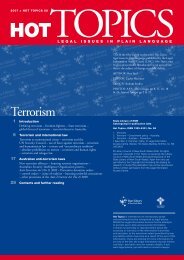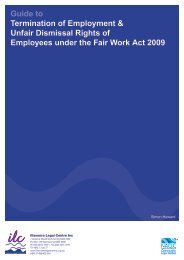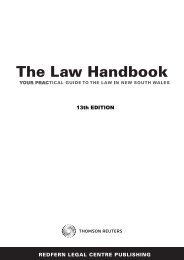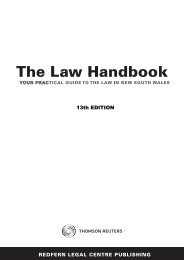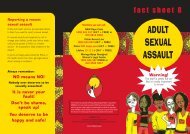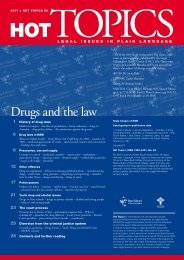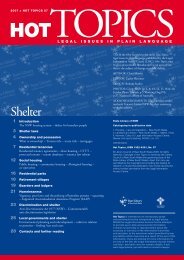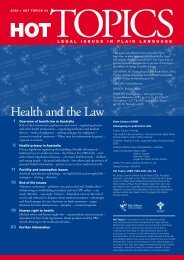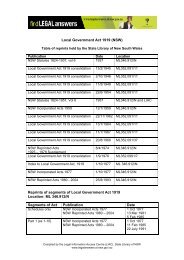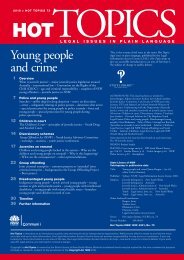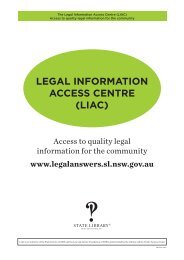Prisoners - Legal Information Access Centre - NSW Government
Prisoners - Legal Information Access Centre - NSW Government
Prisoners - Legal Information Access Centre - NSW Government
You also want an ePaper? Increase the reach of your titles
YUMPU automatically turns print PDFs into web optimized ePapers that Google loves.
the level of provision of rehabilitative programs,<br />
literacy, education, work skills, psychological,<br />
psychiatric, drug and alcohol programs in the prison<br />
context;<br />
> the provision of remissions and parole;<br />
> the level of provision of post-release services such<br />
as housing, education, employment and training<br />
assistance, drug and alcohol and other programs;<br />
> the portrayal of crime problems in the media;<br />
> the degree to which criminal justice issues have<br />
become politicised and the subject of ‘law and order<br />
‘auctions’ between political parties, especially in the<br />
lead up to elections; 38<br />
> public attitudes and sensibilities towards crime,<br />
offenders and rehabilitation.<br />
HigH indigenOus imprisOnmenT<br />
rATes<br />
The marked over-representation of Indigenous<br />
Australians is one of the distinguishing features of<br />
Australian imprisonment. On 30 June 2007 Indigenous<br />
prisoners made up 24% or one in four of all Australian<br />
prisoners. Nationally, Indigenous persons were 13 times<br />
more likely to be in prison than non-Indigenous persons<br />
and in WA, 21 times more likely.<br />
The national imprisonment rate per 100 000<br />
Indigenous adults in 2006-07 was 2142.2 compared<br />
with a rate of 122.4 for non-Indigenous prisoners<br />
<strong>Prisoners</strong>/100 000 adults<br />
4 000<br />
3 500<br />
Indigenous prisoners<br />
3 000<br />
Non-Indigenous prisoners<br />
2 500<br />
2 000<br />
1 500<br />
1 000<br />
500<br />
0<br />
<strong>NSW</strong> VIC QLD WA SA TAS ACT NT AUST<br />
Source: Report on <strong>Government</strong> Services 2008.<br />
© Commonwealth of Australia.<br />
The disproportion is also steadily increasing. Indigenous<br />
prisoners comprised around 5% of the New South Wales<br />
(<strong>NSW</strong>) prison population in the early 1980s, but four<br />
times that proportion (20%) by 2007. 39 Nationally<br />
the proportion of Indigenous prisoners increased from<br />
18% in 1996 to 24.4% in 2006. 40 With a national<br />
Indigenous imprisonment rate of 2142.2 per 100,000<br />
Indigenous adults in 2006-07 compared with 122.4 for<br />
non-Indigenous prisoners the question arises whether<br />
the imprisonment of Indigenous people in Australia<br />
has taken on the characteristics of ‘mass imprisonment’<br />
(as discussed in relation to the US on p 9). The<br />
‘normalisation’ of the prison for Indigenous communities<br />
can be seen in the fact that 20% of Indigenous children<br />
in Australia have a parent or carer in prison, raising the<br />
prospect of increasing inter-generational transmission of<br />
prison culture and experience. 41<br />
The higher incarceration rates of jurisdictions like the<br />
Northern Territory and Western Australia may be due<br />
to having more punitive ‘frontier’ cultures in which<br />
disputes over colonial dispossession of Indigenous people<br />
are both more visible and continuing. 42 Also, high<br />
Indigenous incarceration rates in the last quarter of the<br />
20th century coincide with the end of predominantly<br />
administrative forms of segregation and control through<br />
the mission system, the granting of citizenship and entry<br />
into the labour market. 43<br />
The following quote makes a similar point about the<br />
climb in Indigenous incarceration rates and the issue of<br />
deaths in custody:<br />
By removing the majority of indigenous people<br />
from the spheres of everyday life and establishing<br />
a separate criminal justice apparatus to regulate<br />
their lives in isolation, the reserve system<br />
actually postponed the inevitable passage of<br />
large numbers of the dispossessed victims<br />
of colonisation into the state penal systems<br />
… Moreover, the incapacitating effects of the<br />
reserve system itself – its destruction of cultural<br />
traditions and independence, and the erosion of<br />
health and wellbeing – without doubt exacerbated<br />
the post protection process of incarceration. 44<br />
Child ‘separation’ policies (more commonly known as<br />
the ‘stolen generation’) as revealed in the Australian<br />
Human Rights and Equal Opportunity Commission<br />
(HREOC) report, Bringing them home: Report of the<br />
National Inquiry into the Separation of Aboriginal and<br />
Torres Strait Islander Children from Their Families (1997)<br />
also had clearly criminogenic (crime producing) effects.<br />
Removal from the family and institutionalisation<br />
in juvenile homes cut Indigenous children off from<br />
the protection and influence of their families and<br />
communities and socialised them into the often brutal<br />
regimes of institutional life. This process generated<br />
institutional careers, juvenile homes proving to be<br />
training grounds for prison.<br />
38. See R Hogg and D Brown, Rethinking Law and Order (1998) Pluto Press: Sydney.<br />
39. ABS <strong>Prisoners</strong> in Australia 2007 (2008) 40.<br />
40. As above, at p 43.<br />
41. M Levy, Presentation to National Criminal Justice Forum, Canberra, September 29 2008.<br />
42. As suggested by R Broadhurst, in Aborigines and Crime in Australia’ (1997) in M Tonry (ed) Ethnicity, crime and immigration: Comparative<br />
and cross-national perspectives on crime and justice –a review of research, Volume 21 Chicago, Univ of Chicago Press 453-64.<br />
43. R Hogg, ‘Regulating Indigenous Peoples in Australia’ (2001) Punishment and Society 3(3) 355-379.<br />
44. M Finnane and J McGuire, ‘The uses of punishment and exile: Aborigines in colonial Australia’ (2001) Punishment and Society 3(2) 279-298<br />
at 294.<br />
8<br />
HOT TOPICS 67 > <strong>Prisoners</strong>



